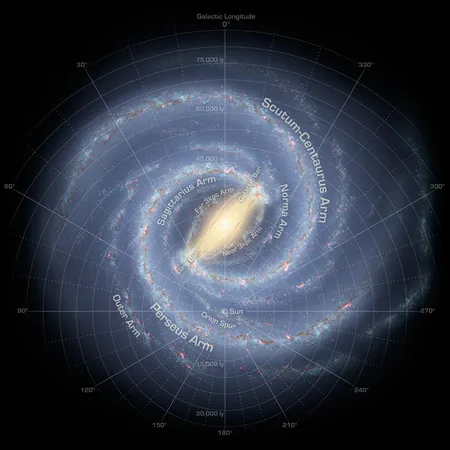
Unlocking the Milky Way's Secrets: A Bold New Theory on Dark Matter
2025-04-16
Author: Charlotte
Astounding Mysteries of the Milky Way Revealed
For decades, astronomers have been captivated by two enigmatic phenomena at the heart of our galaxy. The first is the surprising ionization of gas in the central molecular zone (CMZ), a dense cluster located near the Milky Way’s core. This ionization occurs at astonishing rates, hinting at processes far beyond our current understanding.
The second mystery centers around an unexplained gamma-ray glow at 511 kilo-electronvolts (keV), a specific energy level that signals the annihilation of electrons and their antimatter counterparts, positrons. This intriguing pair of phenomena has perplexed scientists, leaving them scratching their heads in search of answers.
A Revolutionary Theory Linking Dark Matter to Galactic Mysteries
In a groundbreaking study published in Physical Review Letters, researchers propose an exciting possibility: both mysteries could stem from a new form of dark matter, a rare phenomenon less massive than the dark matter types we've typically sought.
The CMZ spans nearly 700 light-years and hosts some of the galaxy's densest molecular gas. Though various sources, such as cosmic rays and starlight, might contribute to the ionization, they don’t fully account for the observed levels. Similarly, numerous candidates have been tossed around for the source of the 511 keV emissions, including everything from supernovas to black holes. However, none could provide a satisfying explanation.
The Light Dark Matter Hypothesis
The researchers pose a daring question: could both phenomena be the result of a hidden process, one involving elusive dark matter? While dark matter constitutes about 85% of the universe's mass, its true nature has remained largely mysterious. One overlooked possibility is that dark matter might consist of low-mass particles—sometimes referred to as sub-GeV dark matter—that could interact with their antiparticles.
In exploring this hypothesis, the study revealed that if these light dark matter particles encountered their antiparticles in the galactic center, the resulting annihilation would produce electrons and positrons. These low-energy particles would then quickly ionize surrounding hydrogen molecules, matching the observed ionization profiles perfectly.
The Connection Between Two Cosmic Signals
This close relationship between dark matter and positron production could explain why positrons, created in the CMZ, eventually collide with electrons, generating gamma rays at the mysterious 511 keV energy level. This striking correlation potentially signifies that both observations are linked to the same source: light dark matter.
A Path Forward in Dark Matter Research
Regardless of whether the 511 keV emissions and CMZ ionization share a common origin, the study's findings provide an invaluable new avenue for unpacking the nature of dark matter. As future telescopes with enhanced resolution come online, they’ll offer greater insight into spatial relationships between these cosmic signals.
The CMZ thus emerges as a critical observational target that could unravel long-standing mysteries. What's clear is that the heart of our galaxy still holds many secrets waiting to be discovered, reminding us that the universe is full of revelations just waiting to be unveiled.









 Brasil (PT)
Brasil (PT)
 Canada (EN)
Canada (EN)
 Chile (ES)
Chile (ES)
 Česko (CS)
Česko (CS)
 대한민국 (KO)
대한민국 (KO)
 España (ES)
España (ES)
 France (FR)
France (FR)
 Hong Kong (EN)
Hong Kong (EN)
 Italia (IT)
Italia (IT)
 日本 (JA)
日本 (JA)
 Magyarország (HU)
Magyarország (HU)
 Norge (NO)
Norge (NO)
 Polska (PL)
Polska (PL)
 Schweiz (DE)
Schweiz (DE)
 Singapore (EN)
Singapore (EN)
 Sverige (SV)
Sverige (SV)
 Suomi (FI)
Suomi (FI)
 Türkiye (TR)
Türkiye (TR)
 الإمارات العربية المتحدة (AR)
الإمارات العربية المتحدة (AR)